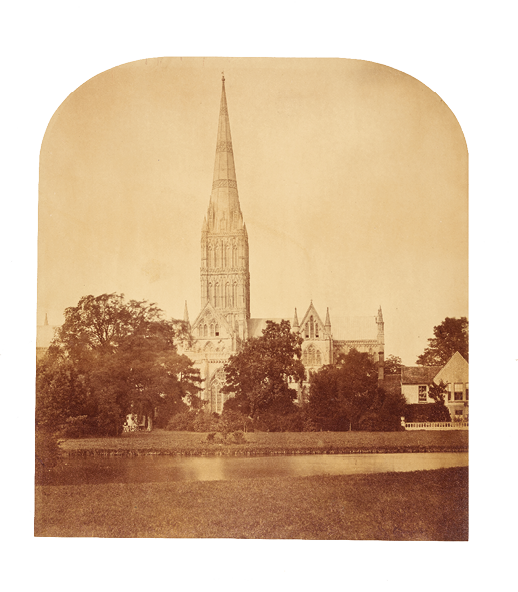This article is taken from PN Review 278, Volume 50 Number 6, July - August 2024.
Pictures from the Rylands LibraryForays in Copyright with Roger Fenton

While architecture was most likely to be chosen by the photographer Roger Fenton as the subject of his work, his preoccupation with landscape was of equal importance to him. Often in the company of his assistant, the ‘indomitable, ingenious and clever’ Marcus Sparling, with their mobile photo-van-cum-dark-room in tow, he went on expeditions throughout Wales, Scotland and England in the 1850s making studies of ‘time-wracked abbeys and weathered cathedrals’ (Gordon Baldwin).
In 1858 Fenton visited Wells, Glastonbury, Lichfield and Salisbury, shown in the photograph here. Placing the cathedral’s tower at its centre, the spire, England’s tallest, ‘almost grazes the photograph’s edge’ (Baldwin). Soaring heavenwards it contrasts with the dark mass of trees, sward and lake in the foreground, a compositional device that alludes to Constable’s ‘Salisbury Cathedral from the Bishop’s Ground’ of 1825. Fenton matches Constable’s ‘masterstroke’ achievement of ‘reconciling the stately tower with the relatively level surrounding terrain’ (William Vaughan), but in a new medium that denied him the painter’s prerogative for being ‘casual with the truth’ (Vaughan).
At the time of the photograph’s making, art and its theories were much on Fenton’s mind: he was one of only two photographers on the Society of Artists Copyright Committee whose chief object was to ‘secure a copyright for such designs of an artist as he may himself have conceived, and as have been produced by his own hands’. As a fully-fledged barrister and artist schooled in the studios of Charles Lucy in London and Paul Delaroche in Paris, Fenton was well placed to contribute to the debate. Yet in advocating for the new medium, he had his work cut out on a committee composed largely of painters who felt that ‘photographers were not entitled to rank among artists but must be content to claim their copyright protection as reproducers of art’ (Fenton).
Keen to dismiss photography as a tool rather than a medium of Fine Art, these Academicians imposed a model of copyright based on ideas which drew distinctions between mental and mechanical labour. That the legal classifications embedded in copyright ‘were often perceived as providing institutional evidence of artistic status and social standing’ (Elena Cooper) also threw issues of class, power and privilege into the mix of their hostility. For, ‘living in grand houses and sending their sons to the great public schools’, the high earnings of the painters of the 1850s ‘gave impetus to the social rise not just of the individuals but the profession itself’ (Paula Gilbert). Defending their interests, they voted for photography’s exclusion from the Fine Art category of protection behind Fenton’s absent back.
Meanwhile, in Salisbury, Fenton could be found parking his tanks – or more accurately his photo van (visible for all to see under the trees) – on Constable’s lawn. And through this device, deliberately and defiantly he makes present the means of photographic production within a photographic work that bears the imprint of his creative agency and asrtistic personality, and so stamps it with the hallmark of Fine Art.
‘View of Salisbury Cathedral’, by Roger Fenton, 1858.
(© Image provided by The John Rylands Research Institute and Library, The University of Manchester, 2024)
This article is taken from PN Review 278, Volume 50 Number 6, July - August 2024.




